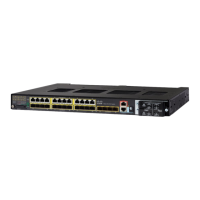874
Configuring IP Unicast Routing
Configuring ISO CLNS Routing
DETAILED STEPS
To disable IS-IS routing, use the no router isis area-tag router configuration command.
EXAMPLE
This example shows how to configure three routers to run conventional IS-IS as an IP routing protocol. In conventional
IS-IS, all routers act as Level 1 and Level 2 routers (by default).
Command Purpose
1. configure terminal Enter global configuration mode.
2. clns routing Enable ISO connectionless routing on the switch.
3. router isis [area tag] Enable the IS-IS routing for the specified routing process and
enter IS-IS routing configuration mode.
(Optional) Use the area tag argument to identify the area to which
the IS-IS router is assigned. You must enter a value if you are
configuring multiple IS-IS areas.
The first IS-IS instance configured is Level 1-2 by default. Later
instances are automatically Level 1. You can change the level of
routing by using the is-type global configuration command.
4. net network-entity-title Configure the NETs for the routing process. If you are configuring
multiarea IS-IS, specify a NET for each routing process. You can
specify a name for a NET and for an address.
5. is-type {level-1 | level-1-2 |
level-2-only}
(Optional) You can configure the router to act as a Level 1 (station)
router, a Level 2 (area) router for multi-area routing, or both (the
default):
level-1—act as a station router only
level-1-2—act as both a station router and an area router
level 2—act as an area router only
6. exit Return to global configuration mode.
7. interface interface-id Specify an interface to route IS-IS, and enter interface
configuration mode. If the interface is not already configured as a
Layer 3 interface, enter the no switchport command to put it into
Layer 3 mode.
8. no shutdown Enable the interface if necessary. By default, UNIs and ENIs are
disabled and NNIs are enabled.
9. ip router isis [area tag] Configure an IS-IS routing process for ISO CLNS on the interface
and attach an area designator to the routing process.
10. clns router isis [area tag] Enable ISO CLNS on the interface.
11. ip address ip-address-mask Define the IP address for the interface. An IP address is required
on all interfaces in an area enabled for IS-IS if any one interface is
configured for IS-IS routing.
12. end Return to privileged EXEC mode.
13. show isis [area tag] database
detail
Verify your entries.
14. copy running-config
startup-config
(Optional) Save your entries in the configuration file.

